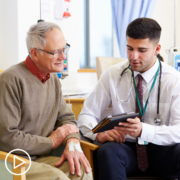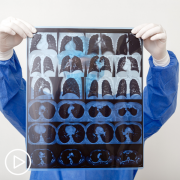Do Myeloma Treatment Advancements Create Care Challenges?
Do Myeloma Treatment Advancements Create Care Challenges? from Patient Empowerment Network on Vimeo.
Are multiple myeloma treatment advancements creating challenges in patient care? Dr. Craig Cole from Karmanos Cancer Institute and advanced practice provider Charise Gleason discuss advancements in myeloma treatment options and combinations and navigating the rapid pace of new treatment information.
Download Resource Guide | Descargar guía de recursos
Related Resources:

|

|

|
Transcript:
Dr. Nicole Rochester:
We know that there has been rapid advancement in the myeloma sphere. Can you speak to how the introduction of novel drugs, treatment combinations and therapeutic modalities may pose some challenges for healthcare providers as they attempt to explain the sequence of treatment in relation to available clinical trials?
Dr. Craig Cole:
Yeah, that’s a really good question, especially because so many things have been changing in myeloma, and such a rapid secession. It really, it’s been kind of not only an incredible transformative past 20 years in myeloma as we’ve moved away from using chemotherapy to using really targeted therapy, but really in the past five to 10 years, and us using immunotherapy and now T-cell directed therapy, it’s been transformative.
And it’s been very, very difficult for myeloma experts to kind of configure how these treatments are sequenced, and how the clinical trials are conducted. But basically, we have gone from using single drug therapies to using combination therapies for refractory patients to using multiple modalities and as upfront therapy for myeloma. Up until today, us using four-drug induction therapies with IMiDs proteasome inhibitors and now immunotherapy with anti-CD38 therapy being used upfront.
Now, we have…we’re on the fact we are past the horizon of using T-cell directed therapy for relapsed/refractory myeloma. Those are now being put in combinations. And at the last meetings, we saw data in combining talquetamab with the bispecific antibody with pomalidomide (Pomalyst) having incredible response rates to 99 percent to a 100 percent. The combination of using daratumumab (Darzalex) with teclistamab (Tecvayli) at ASCO a couple of years ago having very, very, very high response rates for relapsed/refractory patients. And, of course, the combination of using two bispecific antibodies talquetamab (Talvey) and teclistamab together having, again, in these incredible response rates and for relapsed/refractory myeloma. So in very quick orders, we’re going to see those therapies moving further and further upfront, which is a huge benefit to patients.
But it can be kind of difficult to keep up with all the changes in myeloma, especially as we move from using these drugs as single agents, to using them in combination. And not only to speak to using some of the newer drugs like Mezigdomide in combination with daratumumab, having one of the CELMoDs having very, very high response rates. And so it’s exciting, but it does, it’s a challenge to discuss clinical trials with patients, because so many things have changed. We now have clinical trials across the spectrum of myeloma, using bispecifics as upfront and smoldering myeloma, which was at the last ASH meeting to using again, more novel therapies upfront and relapsed/refractory space and in the maintenance therapy space.
Dr. Nicole Rochester:
Well, that’s all very exciting, and I appreciate you sharing that because as you’ve said, there’s been a really kind of an explosion for lack of a better word, in the numbers of treatments that are available as well as increasing improvements and results. But as you shared, having all of these different modalities available can definitely cause some confusion even among those who do this every day. Do you have anything to add to that, Ms. Gleason?
Charise Gleason:
No, I think, well, I think Dr. Cole described that perfectly. It’s an exciting time, and also a challenging time, which just really brings you back to that team care approach to your patient, and how all of us need to work hard to keep up to date on the latest information. Dr. Cole mentioned quadruplet therapy, and we’ve got two clinical trials that have essentially told us if you add that quadruple therapy and add that antibody upfront, you drive that deeper response. So we change our practice probably sooner in the academic settings. And it’s really how do we get this out to other healthcare providers in our referral basis that send patients to us? And then also, how do we do maintenance? And I think Dr. Cole would agree most of us risk-stratify for that maintenance setting too, whether it’s one drug or multi-drug, depending on our patient’s disease.










